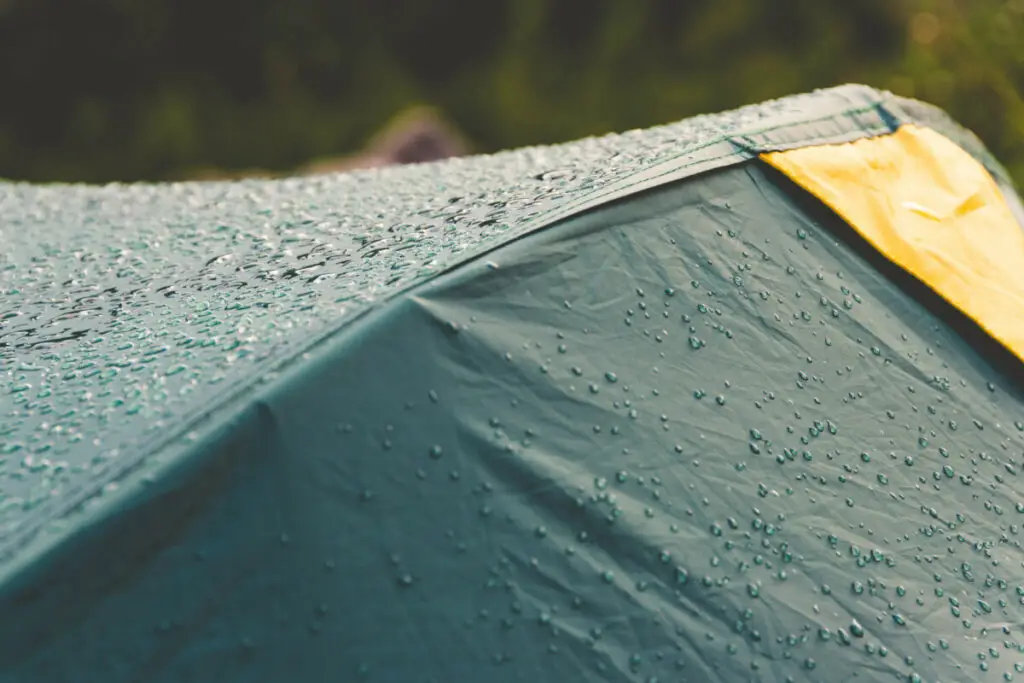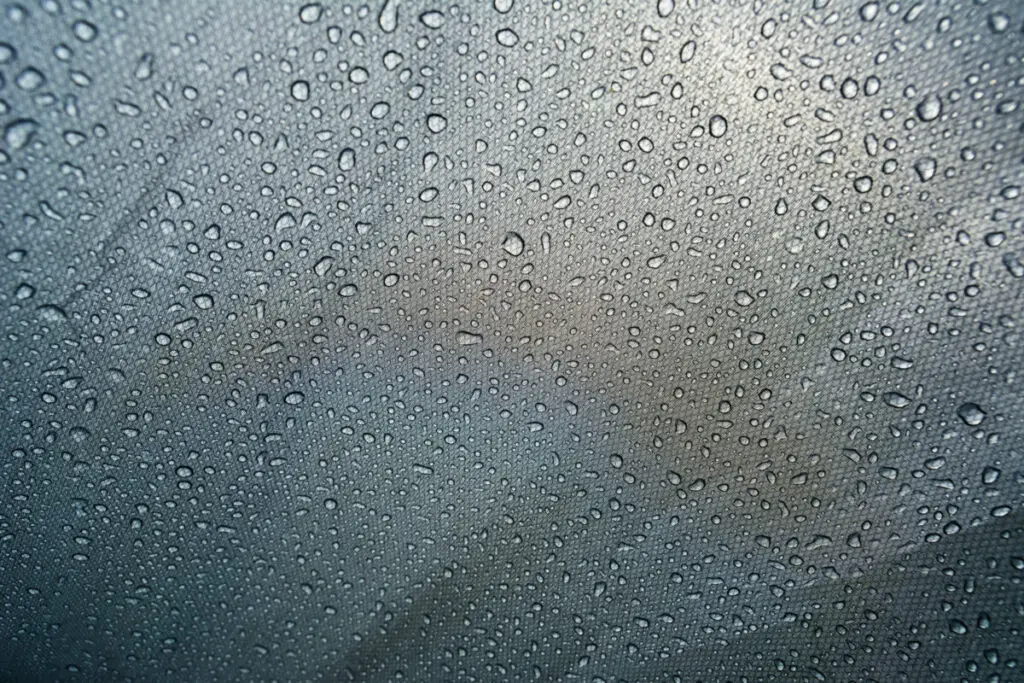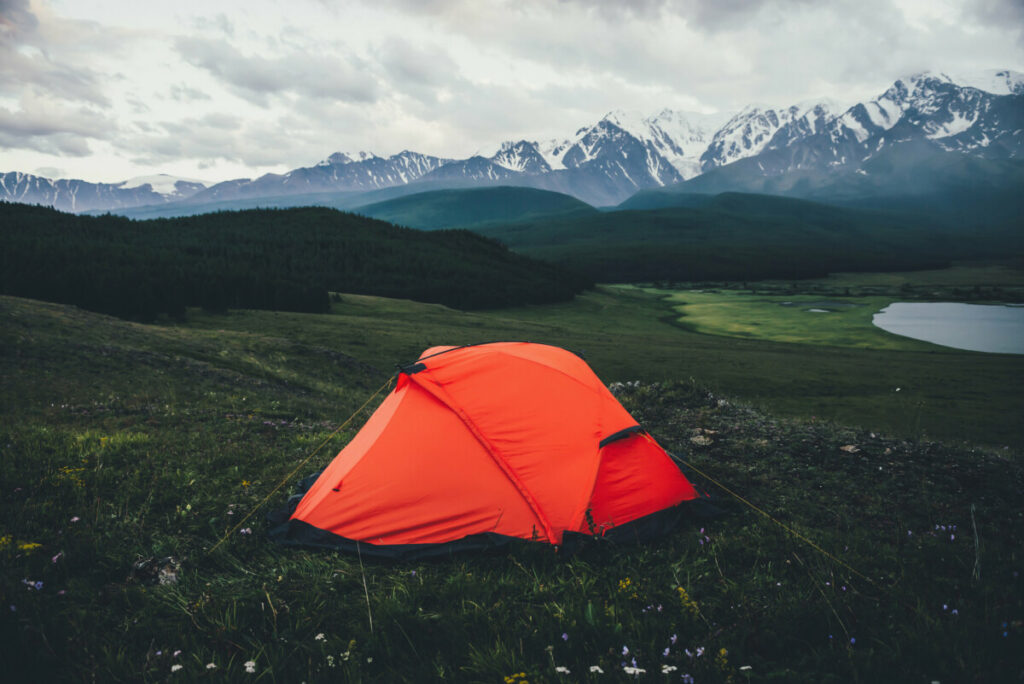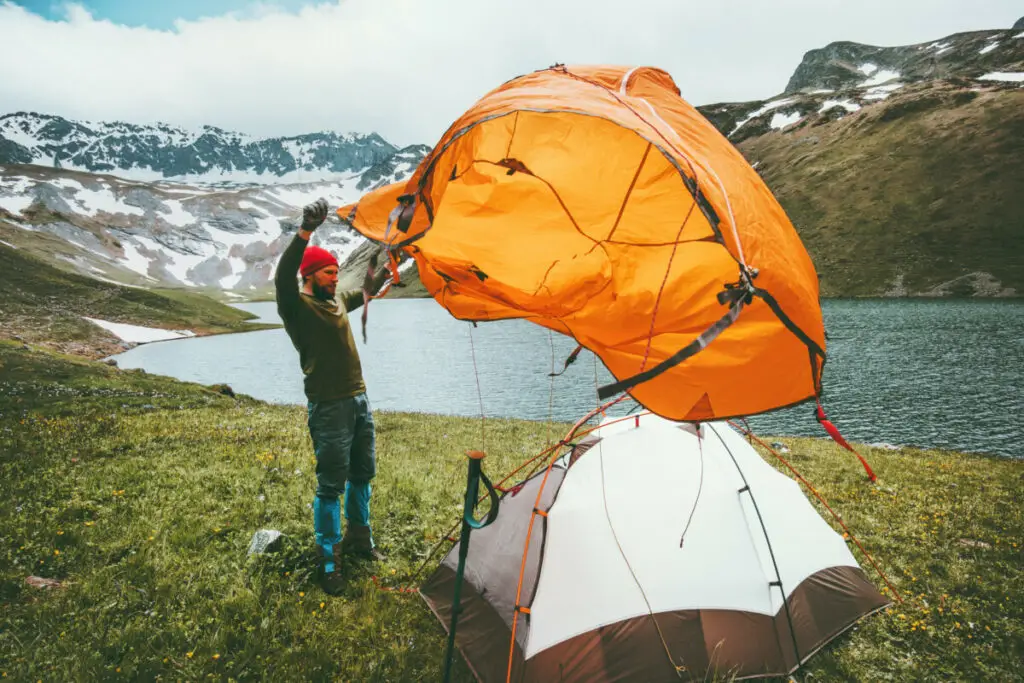
Waking up in your tent completely drenched in water is never a pleasant way to start your day. Condensation build-up is a problem that pretty much every camper, from beginner to the most experienced, has had to deal with. So, how do you stop condensation from forming in your tent?
While it is impossible to completely stop condensation in a tent, condensation build-up can be reduced through various tactics. Maximizing ventilation, avoiding damp environments, and reducing the temperature gradient are the most effective ways to reduce the build-up of condensation in a tent.
Going forward, in addition to talking about ways you can reduce condensation in your tent, we will also dive deeper into other problems that may result from too much condensation and how you can solve them.
What Causes Tent Condensation?
Condensation can form for two reasons. One way it forms is when warmer air comes in contact with colder objects or surfaces. Due to body heat, the temperature inside a tent is usually about five to ten degrees warmer than the outside temperature. This means that when that warm air collides with the cold tent wall, condensation forms naturally.
One of the best ways to understand how this type of condensation is formed is to think of a nice, cold soda can on a hot summer’s day. As we all have experienced, if you have a cold drink outside on a hot day, the can or glass will start to “sweat”. This is caused by the difference in temperature between glass and the air which causes droplets of water to form on the surface.
Condensation also forms when the air becomes too saturated with water molecules. When the water molecules become too heavy for the air, they form water droplets. Every night when we sleep, we breathe out about one to two liters of water. This can cause a high saturation of water molecules in the air- especially in a small, confined space like a tent- which in turn results in condensation in your tent.
“The physics of condensation is not terribly complicated, but the bottom line is that it’s not really plausible to eliminate it completely under all conditions with the type of gear most of us prefer to use. The good news is that a little condensation is not such a big deal. You will learn to live with it.”
Backpacking Light
As stated in the quote above, it is nearly impossible to eliminate condensation all the time, but it is possible to “learn to live with it” and reduce the amount of condensation that accumulates in your tent. A variety of factors goes into creating condensation, but as you understand how condensation is formed and how you might be contributing to it, you will be able to manipulate those factors and have the least amount of condensation possible in your tent. Now let’s learn more about some of those factors.
How to Reduce Tent Condensation

Maximize Ventilation
Lack of ventilation is one of the main culprits of tent condensation. Condensation is caused when the heavily saturated air gets trapped within the walls of the tent, so if you give that air a chance to escape, you’ll enjoy a drier tent.
Many tents have vents or mesh openings you should open to maximize the airflow. In the winter this may lead to you being cold, but it’s better to be cold and dry than cold and wet. If your tent doesn’t have vents or mesh openings, you can open the door of your tent downwind. Opening the door downwind will allow a little more ventilation without freezing you out of your tent.
Avoid Damp Environments
Avoiding damp environments may be the best way to reduce condensation in your tent. In more humid or wet environments like the pacific northwest, condensation is a much larger problem than in a dry environment like the southwest.
Avoid camping when the recent weather has been extremely rainy because the more moisture in the air, the more condensation you will have to deal with when you wake up.
In addition to the general environment you are camping in, you can reduce condensation by choosing a good site to pitch your tent. One avid camper said,
“Site location makes a difference too. If you can stay away from water or low-lying areas, and get up on a breezy ridge, you’ll do much better. Sometimes 50 or 100 vertical feet helps. Ever see fog in the valley from a ridge? Don’t camp down there or you’ll be soaked, no matter how well you ventilate your tent.”
Bike Forums
Avoiding pitching your tent on wet grass or near wet areas like a bog, lake, or river as well as camping under a tree canopy will also help you avoid getting unwanted condensation on the inside of your tent.
Reduce Temperature Gradient
There are a few steps you can take to reduce the temperature gradient between the air inside your tent and outside air. One is opening vents, windows, and doors in the tent. A fan can also increase ventilation and cool down your tent. The closer the temperature inside the tent gets to the outside temperature, the less condensation you’ll experience.
Utilize a Humidity Reducing Product
If none of these methods have worked for you, you may want to invest in a humidity-reducing product such as a dehumidifier, DampRid, or Arm & Hammer moisture absorbers. These and similar products work to reduce the concentration of water molecules in the air which will leave you with a dry, condensation-free environment.
There are pros and cons to each type of moisture absorber. For example, a dehumidifier would probably not be the best option for backpackers as it runs on electricity and needs a reliable source of power. DampRid and Arm & Hammer moisture absorbers work without power and are also the less expensive option.
What Type of Tent will Have the Least Condensation?

Believe it or not, the type of tent you have will contribute greatly to the amount of condensation you will likely find in your tent. There is a variety of tents available to campers today. Some are lighter for backpacking or trekking, while others verge on being called mansions for their huge size. No matter what situation you need your tent for, tents with better airflow, a quality rainfly, and thoughtfully placed airflow vents are best suited for avoiding condensation.
Single wall Tents
If you live in a drier environment, a single-wall tent will probably handle condensation well enough for your needs. However, if you live or camp somewhere where condensation is a big problem, a single wall tent may not cut it. Single wall tents are usually cheaper, lighter, and easier to use than their double-walled counterparts.
As their name suggests, single-wall tents are composed of a single sheet of fabric that is usually lightweight and waterproof. However, the fabric varies in terms of breathability. This means that you will have more condensation in a single wall tent.
Double-wall Tents
Double-wall tents are composed of two walls- the inner wall being light and breathable, with the outer wall being heavier and waterproof. These walls allow for humidity and air to escape while providing protection from the rain. Something unique about double-wall tents is that they are usually warmer than single-wall tents because air gets trapped and warmed in the space between the layers providing an extra layer of insulation against the cold.
These kinds of tents tend to be bulky and expensive as they are made of more material. All the same, a double-wall tent would be the right choice for you (and worth the investment) if weight isn’t that big of an issue and if you live or tend to camp in a wet, humid environment.
What to Do if Your Gear Gets Wet from Condensation
Wet gear is one of the most aggravating things that happens camping, and it can become even worse through too much condensation in your tent. If your tent gets wet from condensation, it is best to let it dry before packing it up. Another option is to bring a towel or sponge to soak up the water that accumulates on your tent throughout the night. Gear other than your tent experience the negative effects of condensation.
If your sleeping pad gets wet, it is best to first dry it off with a towel or sponge. If you have the time, you should air-dry your pad and then store it unrolled with the valve open. Condensation can also build up under your sleeping pad. You can also dry this off with a towel, or if you would like to prevent it, you should put down another mat or waterproof material.
A wet sleeping bag can prove to be not only uncomfortable but detrimental if you are camping in cold weather. If your bag gets wet, first squeeze out any moisture you can and then let your sleeping bag air out. You can also put your sleeping bag in the dryer on low heat to speed up the process.
How to Maintain Your Tent

Maintaining your tent is one of the best ways to keep it in good condition as well as prevent too much moisture from getting in. When you properly maintain your tent, you will experience two main benefits. One reason you should maintain your tent well is that it will provide you with better quality and ease of use during that season. Another is that your tent will last longer, which will give you a higher return on your investment. Tents are expensive and you get the most bang for your buck when you take care of them.
Tips on Maintaining Your Tent
- Make sure to set up your tent on flat, level ground. This will prevent your tent from being oddly stretched, or putting pressure in places it shouldn’t have it.
- Avoid setting up your tent in direct sunlight. UV rays can be extremely harmful to tents and reduce the effectiveness of waterproof coatings on the fabric.
- Sealing the seams and waterproofing your tent will keep you warm and dry inside while protecting the tent seams and fabric.
- Using a ground cloth or cover will not only keep your tent clean but protect it from sharp rocks or sticks that might tear the fabric.
- Don’t wear your shoes inside the tent. Wearing your shoes will track in dirt and bugs that can prove to be harmful to your tent.
- Don’t keep your food in the tent. Storing food in the tent can attract critters small and large alike who won’t hesitate to chew or tear a hole in your tent to get a snack.
- Always make sure to clean your tent. Having a clean tent means that the dirt, grime, bacteria, and even mold that might be on your tent won’t be on there long enough to have a chance to do much damage.
- Store your tent well. This means making sure that the tent is completely dry before loosely rolling it and storing it in its bag. It is also important to store your tent in a dry, cool place where it won’t collect too much dust.
Camping Responsibly
Camping responsibly will create an overall better experience for you and your group. One of the keys to camping responsibly is understanding the environment around you. This will help you camp safely and ensure that others are safe as well. When you understand important factors like weather and condensation, you will be better prepared to face challenges as they arise and overall enjoy your experience more.
When camping in a tent, you should not manipulate the environment by cutting back brush or trees to create a campsite. This is not only illegal in most natural parks and forests, but harmful to the environment. If you decide to make a fire at your campsite, ensure that it isn’t too close to your tent or timber that could easily catch fire. As always, keep your fires small and put them out completely before leaving your campsite.

